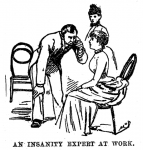
May is the birth month of Elizabeth Cochrane Seaman, better known as “Nellie Bly“. Here at OpenSTEM, we have a great fondness for Nellie Bly – an intrepid 19th century journalist and explorer, who emulated Jules Verne’s fictional character, Phileas Fogg, in racing around the world in less than 80 days in 1889/1890. Not only was she a bold individual with a keen eye for detail and a gifted wordsmith who could capture an audience with her tales of her exploits, but she was also a thoroughly investigative journalist with a sharp interest in social justice.
 She was born 154 years ago in a part of Pittsburgh, USA, named after her father, Michael Cochran, who had worked his way up from being a labourer to a major landowner, postmaster and respected justice. A passionate advocate for women’s rights from the age of 16, her eloquence landed her a job as a writer for the local newspaper. At the age of 21, she served as a foreign correspondent in Mexico, later publishing her experiences in a book. She was forced to flee Mexico after criticising the Mexican government for imprisoning a local journalist.
She was born 154 years ago in a part of Pittsburgh, USA, named after her father, Michael Cochran, who had worked his way up from being a labourer to a major landowner, postmaster and respected justice. A passionate advocate for women’s rights from the age of 16, her eloquence landed her a job as a writer for the local newspaper. At the age of 21, she served as a foreign correspondent in Mexico, later publishing her experiences in a book. She was forced to flee Mexico after criticising the Mexican government for imprisoning a local journalist.
Emboldened by this experience, she decided to embark on an even more dangerous assignment and, with the support of Joseph Pulitzer’s newspaper, the New York World, she feigned insanity to go undercover inside a women’s mental asylum and report on the conditions there. After 10 days, the World intervened to have her released and her damning report, later published as the harrowing account: “Ten Days in a Mad-House” did lead to an increase in funding for these institutions and some reforms.
 Nellie’s next exploit was to attempt to match the journey from Jules Verne’s novel “Around the World in 80 Days”. The attempt became a race with a rival newspaper fielding another candidate, travelling in the opposite direction. As in the novel, using steamships and railways, Bly started on 14 November, 1889 and travelled through England, France (where she met Jules Verne), Italy, Egypt, Sri Lanka, Penang, Singapore, Hong Kong and Japan (as well as a visit to a leper colony in China). She sent short updates on her progress by telegraph from most places, now connected by submarine cables for the new electric telegraph network. She returned victorious to New York a mere 72 days later, on 25 January, 1890, also beating her rival by 4 1/2 days. Her success inspired a board game, no doubt helping 19th century children with their Geography knowledge!
Nellie’s next exploit was to attempt to match the journey from Jules Verne’s novel “Around the World in 80 Days”. The attempt became a race with a rival newspaper fielding another candidate, travelling in the opposite direction. As in the novel, using steamships and railways, Bly started on 14 November, 1889 and travelled through England, France (where she met Jules Verne), Italy, Egypt, Sri Lanka, Penang, Singapore, Hong Kong and Japan (as well as a visit to a leper colony in China). She sent short updates on her progress by telegraph from most places, now connected by submarine cables for the new electric telegraph network. She returned victorious to New York a mere 72 days later, on 25 January, 1890, also beating her rival by 4 1/2 days. Her success inspired a board game, no doubt helping 19th century children with their Geography knowledge!
She went on to marry a millionaire manufacturer, many years her senior, whom she succeeded in business as his health failed, becoming a renowned industrialist in her own right. She was responsible for several innovations and inventions (such as a new milk can and a stack-able garbage can) and was a staunch supporter of the Women’s Suffrage movement.
Nellie Bly features as one of the explorers in our Women Explorers series. She is included in the list of explorers for the OpenSTEM® Understanding Our World® Unit 5.2 for students in Year 5, although her adventures are suitable for examining historic methods of transport with students in Years 2 and 3, as well as social issues surrounding women’s suffrage and industrialisation for students in Year 6.

The more I see our teachers and students work with the program, the more convinced I am that we have…
Cheryl Rowe, Principal